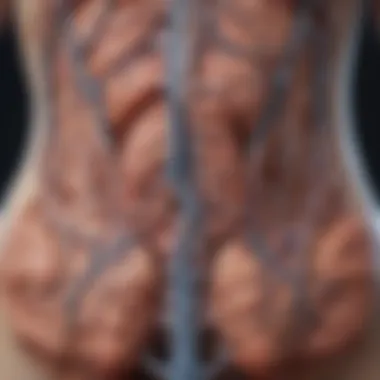Presacral Lymph Nodes in Prostate Cancer: Insights and Implications


Intro
Understanding presacral lymph nodes is crucial in the realm of prostate cancer. These nodes, located in the pelvic region, are significant both in anatomy and in their role in disease progression. As prostate cancer can metastasize through the lymphatic system, the involvement of presacral lymph nodes becomes a vital point of consideration in both diagnosis and treatment plans.
Numerous studies have revealed that the presence of cancer within the presacral lymph nodes can indicate advanced stages of prostate cancer. This has implications not only for patient prognosis but also for the choice of therapeutic strategies. Recognizing this relevance can enhance the overall understanding of metastasis in prostate cancer.
In the following sections, we will delve into the anatomical features of presacral lymph nodes, their involvement in lymphatic drainage from the prostate, and recent advancements in diagnosis and treatment options that highlight their importance. By doing so, we aim to provide valuable insights for healthcare professionals and researchers involved in oncology.
Preface to Prostate Cancer
Prostate cancer remains a significant health concern worldwide. Its implications extend beyond the individual, affecting healthcare systems and societies at large. Understanding prostate cancer is critical for early detection, effective management, and improving patient outcomes. In this article, we will explore several key dimensions of prostate cancer, focusing on the role of presacral lymph nodes as emerging components in the complex landscape of this disease. This exploration is important since presacral lymph nodes can influence both the staging of cancer and its subsequent treatment strategies.
Epidemiology of Prostate Cancer
Prostate cancer is one of the most common cancers among men globally. Statistically, it accounts for a substantial proportion of male cancers, with varying incidence rates depending on geographic and demographic factors. For instance, the risk of developing prostate cancer increases with age, particularly for men over fifty. Additionally, certain ethnic groups, such as African Americans, show a higher prevalence, indicating a potential genetic or environmental link.
Men who have a family history of prostate cancer are at greater risk as well. Awareness of these epidemiological factors can guide screening recommendations and personalized treatment plans. Moreover, screening methods, such as PSA (prostate-specific antigen) tests, have increased detection rates, allowing for earlier diagnosis of the illness.
Pathophysiology of Prostate Cancer
The pathophysiology of prostate cancer is intricate, involving a range of molecular, genetic, and environmental interactions. Abnormal changes in the prostate gland can lead to the uncontrolled cell growth characterized by cancer. Hormones, primarily testosterone, play a pivotal role in this process. The prostate tissue responds to androgens, and alterations in androgen signaling pathways can contribute to carcinogenesis.
At the genetic level, various mutations may trigger the transformation of normal prostate cells into cancerous cells. Notably, alterations in the BRCA1 and BRCA2 genes are increasingly recognized for their association with aggressive forms of prostate cancer. Understanding these mechanisms not only aids in the comprehension of the disease itself but also opens potential avenues for targeted therapies and research into better therapeutic approaches.
In summary, grasping the epidemiological trends and pathophysiology of prostate cancer provides a foundation for understanding its clinical implications and treatment options.
"Recognizing the multifactorial nature of prostate cancer is essential for developing comprehensive diagnostic and treatment protocols."
By investigating the presacral lymph nodes' role, we can further understand metastasis implications and patient management in prostate cancer.
Anatomy of the Presacral Region
Understanding the anatomy of the presacral region is essential for comprehending its relevance in prostate cancer. The presacral area is located posterior to the pelvic viscera and anterior to the sacrum. This region plays a significant role in the lymphatic drainage of the pelvis. Knowledge of its anatomy aids in identifying how cancer can spread via lymphatic channels. Furthermore, recognizing the spatial relationship of the presacral lymph nodes to adjacent structures helps clinicians visualize potential pathways of metastasis.
The presacral lymph nodes can be a critical factor in determining a patient’s prognosis and treatment approach. Therefore, clinicians, researchers, and students must grasp both the descriptive and functional aspects of the presacral region.
Location of Presacral Lymph Nodes
The presacral lymph nodes are situated approximately at the sacral level, specifically between the rectum and the sacrum. Their precise location is crucial for understanding their role in disease spread. These nodes form part of the pelvic lymphatic network and receive lymphatic drainage from the prostate, rectum, and surrounding tissues.
It is important to note that the positioning of these nodes can vary somewhat among individuals, but they consistently serve as a major collection point for lymph from the lower urinary tract. This makes them critical in tracking how prostate cancer may disseminate beyond the prostate gland.
In context of prostate cancer, metastasis to the presacral lymph nodes can influence treatment plans, as involvement here may indicate more advanced disease.
Vascular and Lymphatic Supply
The vascular and lymphatic supply to the presacral area is complex. The blood supply predominantly comes from branches of the internal iliac artery. The accompanying venous return travels through the internal iliac vein. This vascular structure supports the surrounding tissues and plays a key role in the drainage of lymph.
The lymphatic system in the presacral region consists of a network of vessels that drain lymph to the presacral lymph nodes. Understanding this system is crucial for accurate staging of cancer. Tumors can access this network, allowing cancerous cells to enter the lymphatic circulation and establish secondary sites of growth.
Moreover, any blockage or impairment of this lymphatic drainage can lead to further complications, including lymphedema, which must be considered when developing treatment strategies. The relationship between the vascular supply and lymphatic function emphasizes the need for comprehensive approaches in diagnosis and management of prostate cancer.
Role of Lymph Nodes in Cancer Metastasis
The role of lymph nodes in cancer metastasis is critical. It reflects how cancer spreads and establishes itself in different areas of the body. Understanding this mechanism is essential for addressing prostate cancer effectively. Lymph nodes, including the presacral lymph nodes, serve as key sites for monitoring the spread of malignant cells. Their involvement influences not only prognostic outcomes but also treatment strategies. Therefore, the study of lymphatic pathways offers insights that can potentially lead to improved patient management.


Mechanisms of Metastasis
Metastasis is a complex series of events. First, cancer cells from the primary tumor invade surrounding tissues. They then enter lymphatic vessels and travel through the lymphatic system. This journey leads to regional lymph nodes where secondary tumors might form. The presacral lymph nodes, in particular, can be involved in the spread of prostate cancer. Research suggests that cancer cells may utilize lymphatic routes to escape the primary site. Understanding the step-by-step process of metastasis helps in targeting therapies effectively.
- Local Invasion: Cancer cells grow beyond their original boundaries.
- Lymphatic Spread: Cells detach and enter lymphatic vessels.
- Lymph Node Colonization: Cells gather in lymph nodes, especially those nearest to the primary tumor.
- Systemic Spread: From lymph nodes, cancer cells can enter the bloodstream and spread to distant organs.
Significance of Lymphatic Drainage
Lymphatic drainage plays a significant role in cancer metastasis. It provides a route for cancer cells to migrate from the prostate to other areas such as the presacral lymph nodes. The cautious evaluation of lymphatic drainage can reveal patterns of metastasis. Identifying involved lymph nodes is particularly valuable for staging and treatment planning.
Key points regarding lymphatic drainage include:
- Early Detection: Tracking lymphatic drainage can help catch metastatic spread early.
- Impact on Treatment: Knowing which lymph nodes are involved aids in deciding on surgery and radiation options.
- Prognostic Value: Metastasis to lymph nodes often correlates with a worse prognosis.
Understanding these factors creates a pathway to more personalized treatment regimens for prostate cancer patients.
"Lymph nodes are crucial checkpoints in the journey of cancer, indicating the level of disease progress and potential intervention points."
These insights clarify the need for deeper research into the lymphatic system's role in cancer. As knowledge accumulates, it will inform future clinical practices and help refine therapeutic approaches.
Presacral Lymph Nodes and Prostate Cancer
The presacral lymph nodes play a pivotal role in understanding prostate cancer. Located in the presacral space, these nodes are often overlooked during cancer staging and treatment planning. Their involvement in the disease process is significant, as they are part of the lymphatic drainage system for the prostate.
When prostate cancer metastasizes, it can spread through the lymphatic system. This observation underscores the importance of assessing the presacral lymph nodes in patients with prostate cancer. Involvement of these nodes can indicate a more advanced stage of the disease, guiding treatment decisions. Additionally, the presence of cancer in these nodes can impact prognosis, leading to different management strategies.
By comprehensively understanding the role of presacral lymph nodes in prostate cancer, healthcare professionals can enhance diagnostic accuracy. This topic is fundamental for both researchers and clinicians aiming to improve patient care in oncology.
Involvement in Prostate Cancer Progression
The involvement of presacral lymph nodes in prostate cancer progression is a complex process. As cancer cells disseminate from the prostate, they often travel to nearby lymph nodes first. The presacral lymph nodes serve as crucial filters, potentially trapping cancer cells. This preliminary involvement can lead to further spread, including distant metastasis.
Research indicates that when cancer affects these nodes, it often correlates with a higher stage of the disease. This can occur through direct extension or lymphatic spread, making it essential to evaluate these nodes during diagnostic procedures.
Several studies demonstrate that the status of presacral lymph nodes can predict cancer outcomes. Patients with node involvement tend to experience worse survival rates. Consequently, this drives the need for accurate imaging to evaluate these nodes in patients suspected of advanced disease.
- Key Considerations:
- Early detection of nodal involvement may reduce metastasis risk.
- Biopsy results from these nodes can provide critical information for staging.
Implications for Staging and Prognosis
The presacral lymph nodes significantly influence the staging of prostate cancer. When staging, traditional methods often focus on distant metastases, glossing over regional nodal involvement. The American Joint Committee on Cancer emphasizes regional lymph nodes, including presacral nodes, in staging criteria.
With presacral node involvement, healthcare professionals may consider a patient as having at least stage T3 disease. This staging alteration has implications for treatment. For example, clinicians might recommend more aggressive therapies to address potential metastasis.
Moreover, the status of these lymph nodes can also alter prognosis. Studies show that patients with affected presacral lymph nodes have reduced survival rates compared to those without such involvement. The insights gained from evaluating these nodes can refine patient management and therapy choices.
Understanding the status of presacral lymph nodes can lead to improved treatment outcomes for prostate cancer patients.
Diagnostic Approaches
Understanding the presacral lymph nodes in prostate cancer requires effective diagnostic approaches. These methods help in identifying the presence of cancer, its extent, and guiding treatment options. Accurate diagnosis can substantially affect patient outcomes. In cancer cases, especially in prostate cancer, irregular lymph node involvement hints at a more aggressive disease. Therefore, precise diagnostic tools are crucial.
Imaging Techniques
MRI


Magnetic Resonance Imaging, or MRI, plays a notable role in the diagnostic journey for prostate cancer. Its ability to provide detailed soft-tissue contrast makes it a preferred choice. This characteristic helps in assessing lymph node involvement with high precision.
The unique feature of MRI is its non-invasive nature. It does not use ionizing radiation, which is a significant advantage over other imaging techniques. However, MRI may present limitations in assessing smaller lymph nodes. Complete scans can be time-consuming, which might not always be feasible for patients.
CT Scans
Computed Tomography, commonly known as CT scans, is another critical imaging technique. What distinguishes CT scans is their speed and availability, often making them a first-line diagnostic tool. This imaging method uses X-ray technology to create cross-sectional images of the body, giving a clear view of the abdominal and pelvic regions where presacral lymph nodes are located.
CT scans can effectively detect enlarged lymph nodes. However, they may not provide the same level of detail as an MRI when evaluating soft tissue. Additionally, reliance on ionizing radiation raises concerns, especially with repeated exposure.
PET Scans
Positron Emission Tomography, or PET scans, is particularly beneficial in assessing metabolic activity. By using a radioactive tracer, PET scans can highlight areas of increased activity, commonly associated with cancer. The combination of PET with CT scans (PET/CT) enhances the diagnostic accuracy, offering complementary data.
The unique advantage of PET scans lies in their ability to assess systemic disease. This can be vital when determining the overall cancer burden. However, high costs and limited availability can be obstacles in some settings.
Biopsy and Histopathological Assessment
Biopsy remains a crucial method in confirming the diagnosis of prostate cancer and assessing the involvement of presacral lymph nodes. This process entails taking a tissue sample for analysis. Histopathological assessment then helps in classifying the cancer type and grading its aggressiveness.
Treatment Strategies
Understanding treatment strategies for prostate cancer is essential for improving patient outcomes. Effective management often integrates various methods, targeting both the primary tumor and any potential metastasis in presacral lymph nodes. Each strategy holds distinct benefits, but also potential drawbacks, necessitating individualized patient care.
Surgical Considerations
Surgery often plays a central role in the management of localized prostate cancer. The aim is to remove the prostate gland and any affected surrounding tissues. When presacral lymph nodes are suspected to be involved, careful staging is necessary.
- Lymph Node Dissection: In some cases, surgeons may perform a lymphadenectomy. This procedure involves removing lymph nodes for analysis. It helps determine the extent of cancer spread. The decision to perform this procedure depends on the cancer's aggressiveness and whether preoperative imaging suggests lymph node involvement.
- Benefits: Surgical removal can significantly decrease cancer burden, potentially leading to improved survival rates. It may also prevent further spread of cancer.
- Considerations: Surgery carries risks, such as infection, or lymphocele formation. There may also be long-term effects on urinary or sexual function. Assessing these risks against the expected benefits is critical.
Radiation Therapy Approaches
Radiation therapy is another cornerstone in the treatment of prostate cancer. It can be employed in several contexts, whether as a primary treatment or as an adjunct following surgery.
- External Beam Radiation Therapy (EBRT): This method uses high-energy rays directed at the tumor site. It can target the prostate as well as the presacral lymph nodes if involvement is detected.
- Brachytherapy: This involves implanting radioactive seeds directly into the prostate. While it primarily focuses on the prostate itself, it can mitigate risks posed by nearby lymph nodes.
- Benefits: Radiation effectively kills cancer cells, often with fewer recovery issues compared to surgery. It can also be used to relieve symptoms in advanced prostate cancer cases.
- Considerations: Side effects may include fatigue, urinary complications, and changes in bowel habits. Timing and planning of treatment are essential to minimize adverse effects and target the cancer effectively.
Systemic Therapy Options
In advanced stages of prostate cancer, or when there is evidence of metastasis to presacral lymph nodes, systemic therapies become increasingly relevant. These treatments can complement local control strategies and are vital in managing advanced disease.
- Hormonal Therapy: Androgen deprivation therapy (ADT) is common in advanced prostate cancer. This approach reduces testosterone levels, slowing the growth of androgen-dependent tumors.
- Chemotherapy: Agents like docetaxel may be employed in metastatic cases, particularly if there is evidence of aggressive disease.
- Targeted Therapy and Immunotherapy: Drugs that specifically target cancer cell mechanisms, or treatments that enhance the immune response against cancer, are also emerging areas. Research continues to explore their effectiveness in combination with traditional therapies.
"Effective treatment requires an understanding of the cancer's behavior and the available therapeutic options."
These systemic therapies can offer meaningful improvements in survival and quality of life. However, systemic therapies can also have extensive side effects, making it crucial to monitor patients closely during treatment.
Emerging Research and Trends
The field of prostate cancer treatment is constantly evolving. Emerging research and trends are critical in enhancing our understanding of the presacral lymph nodes and their implications for more effective management of this disease. This section aims to illuminate innovative strategies and current studies that shed light on the role of presacral lymph nodes in prostate cancer, aiming to provide clinicians and researchers with essential insights.
Innovative Therapeutic Approaches
Innovative therapeutic approaches are vital for improving patient outcomes. Recent studies are exploring novel methods that directly target presacral lymph nodes through various treatment modalities. One key aspect is targeted therapies that focus on specific molecular pathways involved in cancer progression. These treatments aim to minimize side effects by localizing their action, potentially offering higher efficacy with reduced toxicity. Another promising area involves the use of monoclonal antibodies, which can specifically bind to cancer cells and the lymphatic system, enhancing the immune response against tumor cells in the presacral region.
Further investigation into immunotherapy highlights its potential to activate the body’s immune system against cancer, particularly in lymph node involvement. Techniques such as checkpoint inhibitors have shown promise in other cancers, and now researchers are examining their application in prostate cancer.


Additionally, the role of radioligand therapy is gaining attention. This method employs targeted radiopharmaceuticals that can selectively destroy cancer cells while preserving healthy tissue, making it an attractive option for patients with disseminated disease involving presacral lymph nodes.
Clinical Trials and Future Directions
Clinical trials are pivotal in validating emerging therapies. Presently, several clinical trials are assessing the effectiveness of new treatments that involve presacral lymph nodes. The outcomes of these trials can change both clinical practice and patient management strategies.
Future directions in this field involve not only testing new drugs but also optimizing integrated treatment approaches. Combination therapies that utilize surgery, radiation, and systemic treatments could yield improved results, especially in advanced prostate cancer cases. Understanding how these nodes respond to differing treatment regimens will refine therapeutic strategies over time.
Advances in technology, such as liquid biopsies, offer innovative methods for ongoing monitoring of treatment response and disease progression, including lymph node involvement. This could lead to personalized treatment plans that are dynamically adjusted based on a patient's response.
Emerging research into presacral lymph nodes could ultimately change the treatment landscape for prostate cancer, ensuring that patients receive focused and effective interventions.
In summary, the focus on emerging research and trends reflects a broader commitment to improving patient care and outcomes in prostate cancer. Updated knowledge from ongoing studies keeps clinicians informed about the best practices, allowing for better decision-making and tailored treatment plans.
Challenges and Considerations
The topic of challenges and considerations in relation to presacral lymph nodes in prostate cancer is critical. These nodes can influence both disease management and prognosis. By addressing these challenges, medical professionals can improve patient outcomes and enhance the understanding of treatment effectiveness. This section aims to explore limitations in diagnostics and the ethical dimensions that come into play regarding treatment decisions. Understanding these factors is increasingly important as advances in medical technologies and therapeutic strategies emerge.
Limitations in Current Diagnostics
The diagnosis of involvement of presacral lymph nodes is fraught with complexities. Current imaging techniques like MRI, CT scans, and PET scans have limitations. While these methods can identify enlarged or abnormal nodes, they often fail to detect smaller, yet clinically significant, metastases. Not all presacral lymph nodes can be visualized clearly, leading to potential understaging or overstaging of the disease.
Some notable challenges include:
- Sensitivity and Specificity: Imaging techniques often have a trade-off between sensitivity (ability to detect disease) and specificity (ability to rule out disease). This can result in false positives or negatives.
- Access to Nodes: The anatomical position of presacral lymph nodes may hinder access during biopsies. Relatively invasive procedures can carry risks, which can deter their use.
- Technological Limitations: Not all facilities have access to cutting-edge imaging technology. This disparity may result in uneven diagnostic capabilities across different healthcare settings.
These diagnostic limitations can lead to implications for treatment decisions. If presacral lymph nodes are not accurately assessed, it can affect clinical staging and strategies such as radiation or surgical approaches.
Ethical Considerations in Treatment Decisions
Ethics play a significant role in determining the right course of action for patients with prostate cancer, particularly when it involves presacral lymph nodes. Treatment options often come with considerable risks and benefits that must be weighed carefully. Some ethical considerations include:
- Informed Consent: Patients must be made aware of the potential risks associated with surgical interventions or experimental therapies. Providing clear and comprehensible information is vital to ensure that patients can make informed choices about their treatment.
- Risk vs. Benefit Analysis: Healthcare professionals have the responsibility to evaluate whether the potential outcomes of a treatment justify the risks involved. In cases involving presacral node metastasis, assessing the effectiveness of specific treatments becomes essential to ethical care.
- Patient Autonomy: Respecting the wishes and values of the patient is crucial. Healthcare providers should facilitate discussions that allow patients to voice their concerns and preferences regarding treatment.
Overall, these ethical considerations influence treatment pathways and can lead to variations in care. Emphasizing patient-centered approaches while navigating these complexities is necessary to improve outcomes in a population impacted by prostate cancer.
Culmination
The conclusion of this article emphasizes the significant role that presacral lymph nodes play in prostate cancer management. By understanding their function and implications, healthcare professionals can better navigate the complexities of diagnosis and treatment decisions. The insights gathered throughout this discussion underline the importance of recognizing the presence and involvement of these lymph nodes in prostate cancer progression.
Notably, the presacral lymph nodes are often overlooked in clinical practice. They can provide crucial information regarding metastasis. Recognizing their involvement enhances the accuracy of cancer staging. This, in turn, can improve prognostic assessments.
A comprehensive understanding of presacral lymph nodes also contributes to tailored treatment options. As the management of prostate cancer evolves, integrating findings from ongoing research will be vital. This approach ensures that treatment strategies are adaptive to individual patient needs, leading to potentially better outcomes.
"The presacral lymph nodes are critical in understanding the full landscape of prostate cancer metastasis and staging."
In summary, concluding sections of this article reiterate the need for further exploration and acknowledgment of presacral lymph nodes in prostate cancer. The benefits they offer in enhancing diagnosis and informing treatment strategies can significantly impact patient care and clinical practices alike.
Summary of Key Findings
This article highlights several key findings regarding presacral lymph nodes in prostate cancer. Firstly, their anatomical positioning allows them to serve as key indicators of metastatic spread. Understanding their role aids not just in diagnostics but also in predicting cancer progression.
Furthermore, the relationship between lymphatic drainage patterns and metastasis reveals essential insights. The presacral lymph nodes act as potential gateways for cancer spread beyond the prostate, suggesting a need for targeted imaging initiatives.
Also, advancements in imaging techniques have greatly improved visualization of these lymph nodes. MRI, CT scans, and PET scans now can detect involvement earlier, facilitating timely interventions.
Future Research Avenues
Future research is critical for unraveling the complexities surrounding presacral lymph nodes in prostate cancer. Areas requiring further attention include:
- Enhanced imaging modalities: Research could focus on developing more sensitive imaging techniques to detect micro-metastases early.
- Biomarker identification: Finding specific biomarkers within presacral lymph nodes may help predict cancer behavior more accurately.
- Longitudinal studies: Long-term studies could discern the impact of presacral lymph node involvement on patient survival and quality of life.
- Clinical trials: Investigating new therapies that target lymphatic pathways might yield promising treatment options for patients.
The advancement in these areas can ultimately reshape therapeutic strategies, bringing us closer to precision oncology for prostate cancer.







